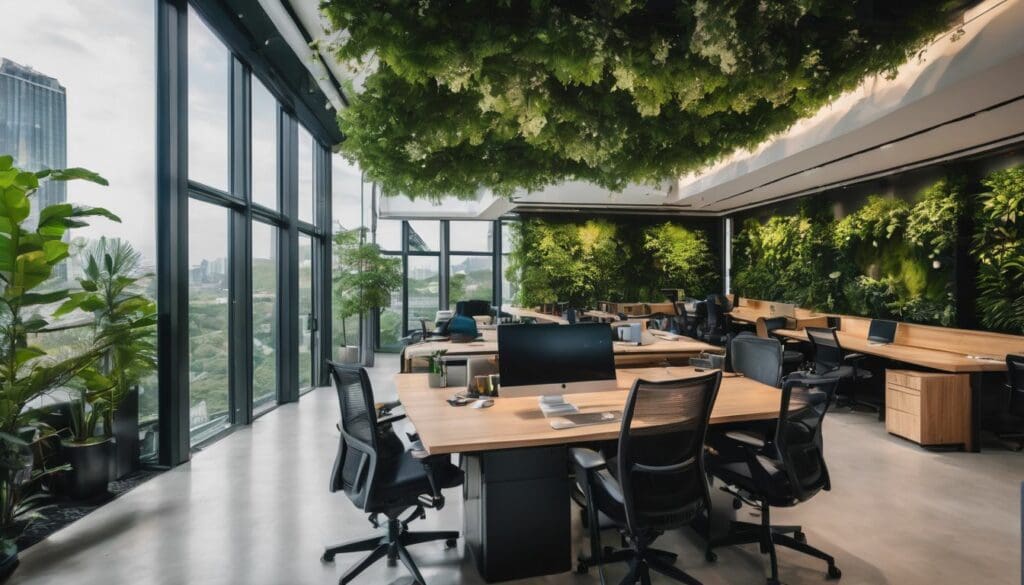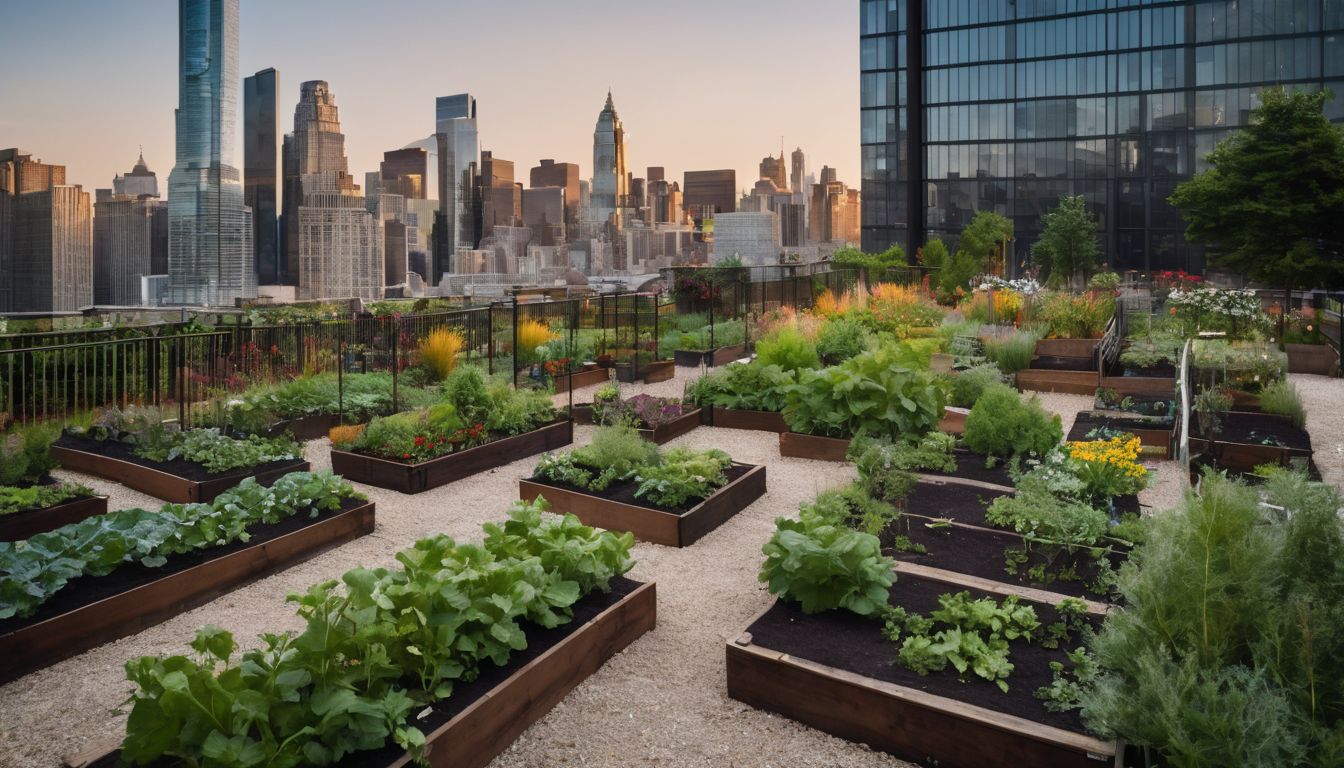Creating energy-efficient homes and offices is becoming more crucial as the world grapples with climate change. Green buildings reduce greenhouse gas emissions by up to 50% compared to standard structures, making them a powerful tool for environmental preservation.
This blog post will guide you through setting up a local initiative that champions sustainable building, promising both planetary and personal gains. Dive in to transform your community one brick at a time!
Key Takeaways
- Green building initiatives are essential for reducing environmental impact and promoting sustainable construction, with benefits including lower greenhouse gas emissions, resource conservation, and enhanced indoor air quality.
- Implementing green building standards like LEED certification can lead to economic advantages such as decreased operating costs and higher property values while contributing to job creation in the green construction sector.
- Collaboration between architects and building owners is crucial for integrating eco-friendly practices into buildings, utilising tools such as energy-efficient technologies and local government incentives to foster sustainability in local communities.
- Successful examples of local green building initiatives include Washington D.C.’s Building Energy Performance Standard program which sets energy efficiency targets for large buildings, showcasing leadership in combating climate change through sustainable urban development.
- Health advantages from green buildings encompass better occupant well – being due to improved indoor environment quality, thus supporting physical health by minimising exposure to pollutants and enhancing mental wellness through nature connectivity.
What is Green Building?
Green building focuses on designing, constructing, and operating buildings in an environmentally responsible way. It aims to reduce the overall impact on the environment and human health while increasing economic benefits through energy efficiency and resource conservation.
Definition
Green building involves creating structures and using processes that are environmentally responsible and resource-efficient throughout a building’s life-cycle. This approach goes from siting to design, construction, operation, maintenance, renovation, and demolition.
It aims for sustainability performance targets such as reducing waste and pollution while enhancing the health of those who use the buildings. These constructions often utilise renewable materials alongside energyefficient technologies to create ecofriendly environments.
Applying these principles helps in transforming buildings for sustainability. They support lowimpact development practices which limit their strain on local resources. The next section explores specific goals and benefits that green building initiatives bring about for communities and the environment alike.
Goals and benefits
Green building aims to reduce environmental impact, promote health and wellness, and create resilient buildings. It also seeks to conserve resources, improve energy efficiency, and enhance community well-being. The main goals and benefits of establishing a local green building initiative include:
- Mitigating environmental impact through sustainable construction practices that minimise waste, reduce carbon emissions, and preserve natural resources.
- Enhancing the health and wellness of building occupants by promoting indoor air quality, natural light, and access to green spaces within the built environment.
- Improving energy efficiency in buildings to lower utility costs and reduce greenhouse gas emissions, contributing to a more sustainable future for communities.
- Creating resilient structures that can withstand extreme weather events while minimising damage to property and ensuring safety for occupants.
- Promoting economic growth and job creation by supporting green infrastructure development and fostering innovation in sustainable construction practices.
- Strengthening community cohesion by engaging local stakeholders in the planning and execution of green building initiatives, fostering a sense of ownership and pride in sustainable development efforts.
- Fostering urban sustainability through the integration of eco-friendly building materials, energy-efficient technologies, and green design principles into the fabric of local infrastructure.
- Demonstrating leadership in environmental stewardship by achieving green building certifications that showcase a commitment to sustainable development practices at a local level.
Green building standards and certifications
Green building standards and certifications are guidelines for creating sustainable and eco-friendly structures. They ensure that buildings are designed and constructed with efficient use of resources, reduced environmental impact, and improved occupant health. Here are some well-recognised green building standards and certifications to consider:
- Leadership in Energy and Environmental Design (LEED) certification encourages sustainable design practices for energy efficiency, water conservation, and indoor environmental quality.
- The Living Building Challenge is a rigorous certification programme that promotes regenerative construction by adhering to strict criteria related to equity, beauty, and human health.
- Passive House certification focuses on ultra-low energy use and high-quality indoor air without compromising comfort or design aesthetics.
- Green Star certification aims to improve the sustainability of buildings through innovation, design excellence, and operational performance.
- BREEAM (Building Research Establishment Environmental Assessment Method) provides sustainable building assessments and certifications based on various environmental categories such as energy, transport, water, materials, pollution, land use & ecology, management – addressing the lifecycle stages of masterplanning projects.
The Importance of Establishing a Local Green Building Initiative
Establishing a local green building initiative is crucial for reducing environmental impact, saving on energy costs, and promoting health and wellness in our communities. By implementing sustainable building practices, we can create a more eco-friendly and resilient infrastructure for future generations.
Environmental impact
Green building initiatives have a significant positive impact on the environment. By implementing sustainable construction practices, such as using renewable energy sources and reducing water consumption, local communities can decrease their carbon footprint and contribute to mitigating climate change effects.
Furthermore, green buildings help in preserving natural resources like timber and water by employing eco-friendly materials and efficient technologies which lower overall environmental degradation.
Applying green building practices also leads to improved air quality within communities, contributing to better health outcomes for residents. Reduced emissions from energy-efficient buildings minimise air pollution levels, making cities healthier places to live.
Economic benefits
Green building initiatives can lead to significant economic benefits for local communities. By adopting sustainable building practices, such as energy-efficient designs and materials, cities can reduce operating costs for buildings and infrastructure.
This not only saves money for taxpayers but also creates job opportunities in the green construction sector, driving economic growth and boosting local industries. Additionally, implementing green building standards can enhance property values and attract businesses to environmentally responsible urban areas.
Local governments embracing green building initiatives will experience reduced utility bills due to improved energy efficiency, freeing up funds for other vital community services.
Furthermore, by investing in eco-friendly construction practices now, cities can mitigate future environmental impact and lower long-term maintenance costs associated with traditional buildings.
Health and wellness benefits
Green building initiatives contribute to improved health and wellness for occupants. By prioritising air quality, natural light, and sustainable materials, these buildings provide a healthier indoor environment.
Green buildings minimise exposure to harmful chemicals and promote physical well-being through accessible green spaces.
Reducing indoor pollutants and fostering a connection with nature positively impact mental health. Overall, promoting healthy living in line with environmental sustainability is key to the success of local green building initiatives.
Successful Green Building Initiatives
Explore successful local initiatives such as Washington, D.C.’s Building Energy Performance Standard program and understand the impact of their efforts to promote green building practices in the community.
Read on to discover how architects and building owners can work together for a more sustainable future.
Washington, D.C.’s Building Energy Performance Standard program
London implements the Building Energy Performance Standard programme to improve energy efficiency in existing buildings, aiming to reduce greenhouse gas emissions and combat climate change.
This initiative affects large buildings over 50,000 square feet that must meet specific energy efficiency targets or face penalties, driving owners and operators to prioritise sustainable building practices.
The programme aims to support community energy efficiency while promoting eco-friendly building development and sustainable infrastructure.
Other examples of successful local initiatives
Other examples of successful local initiatives include the Portland Green Building Initiative, which focuses on sustainable building practices and urban sustainability initiatives. The Chicago Sustainable Development Policy promotes green development and energy-efficient buildings. The New York City Retrofit Accelerator supports community energy efficiency programs, while the San Francisco Better Roofs Ordinance encourages climate-resilient construction. Lastly, the Los Angeles Green Business Program advocates for eco-friendly building and sustainable building initiatives.
How Architects and Building Owners Can Work Together
Architects and building owners can collaborate by utilising tools and resources for implementing green building practices, ensuring that their projects are environmentally friendly and energy-efficient.
If you’re interested in learning more about the importance of local green building initiatives, keep reading to find out how these initiatives can benefit both communities and the environment.
Importance of collaboration
Architects and building owners must collaborate to implement eco-friendly building practices. Sharing expertise and resources can lead to better outcomes in creating energy-efficient, climate-resilient construction.
By working together, they can maximise the health and wellness benefits of green buildings while also achieving environmental sustainability.
Collaboration is crucial for realising the goals of a local green building initiative. It allows architects and building owners to utilise green building certification systems effectively, ensuring that eco-friendly practices are integrated into every aspect of the construction process.
Tools and resources for implementing green building practices
To implement green building practices, consider the following tools and resources:
- Green Building Certification Programmes:
- Energy-efficient Materials and Technologies:
- Sustainable Design Software:
- Local Government Incentives:
- Eco-friendly Construction Techniques:
- Professional Development Resources:
Conclusion
In conclusion, establishing a local green building initiative is vital for promoting environmental sustainability. It allows communities to embrace eco-friendly building practices and contribute to a healthier future.
Architects and building owners coming together can create resilient structures that benefit both people and the planet. Environmental conservation and sustainable living are achievable through such proactive local initiatives.
FAQs
1. What is a Local Green Building Initiative?
A Local Green Building Initiative focuses on creating buildings that promote health and wellness, are eco-friendly, energy-efficient, and designed for climate-resilient construction within communities.
2. Why should local governments consider sustainability in buildings?
Local government sustainability efforts can lead to environmentally friendly building practices that benefit the whole community by reducing carbon footprints and ensuring long-term resilience of structures.
3. How do green buildings contribute to building resilience?
Green buildings use materials and designs aimed at withstanding extreme weather and environmental changes, making them stronger against nature’s challenges while preserving resources.
4. Can energy-efficient building methods save money?
Yes, incorporating energy-efficient techniques into construction not only helps the environment but also reduces ongoing costs related to heating, cooling, and electricity usage in the long run.





